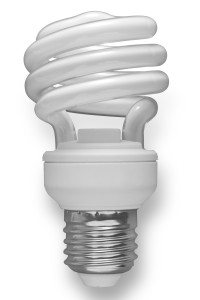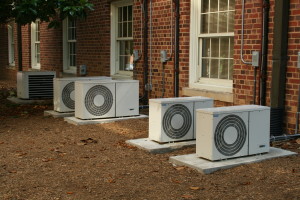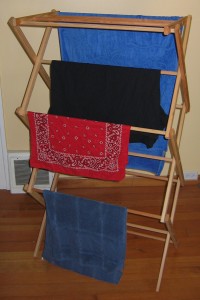We’re getting into the hottest part of the year—and with high temperatures often come outrageous electricity and water bills, which take a toll on your wallet and your peace of mind.
But if you’ve not yet made these 8 simple changes in your daily life, you could be spending your money smarter, seeing smaller bills, and helping reduce your carbon footprint. Best of yet, they’re all $10.00 or less, and many are free!
1. Switch a few lightbulbs from incandescent to compact fluorescent (CFLs)
Although it’s an up-front cost—$8.17 for 4 CFLs, versus $5.46 for 4 incandescents on Amazon—switching even some of your lightbulbs in your home can reduce your replacement cost and save you money on your energy bill. The current research states that CFLs will save you over $40 over the cost of one lightbulb, and pay for themselves in the savings.
Beyond saving you money and minimizing your waste, fluorescent bulbs convert more of the electricity supplied to them into actual visible light, and are less hot than their incandescent counterparts. They also can be recycled at the end of their lives! There has been some concern about mercury within the bulbs, but they emit none of the chemical when in use, and have an easy clean-up if one breaks.
2. Invest in a bottle of caulk for windows and doors
Sure, sure; you’ve been meaning to do this. But now is the time to caulk your windows and doors, to make sure no air is escaping where it shouldn’t. You should also take the time to check your baseboards, your electrical outlets, and your attic (if you have one). A good bottle of caulk is easy to use and certainly costs less than $10. It’s not a glamorous purchase, but it’s exactly what you need to get the job done quickly and efficiently.
3. Change your air conditioning filter
Chances are, if you’re lucky enough to have an air conditioner at home, you’re likely using it more than you’d like. Of course, if the weather ever gets cool enough to allow you to open the windows, you should take advantage of the breeze! But when you’re running the A/C, make sure to take a few moments every month to change the filter, so that it’s working at top efficiency for you. This is fundamentally important for any home, but especially so if you live with pets, near a busy street, or have allergies. Check your unit’s filter size before buying to make sure that you’re getting the right one, or try to buy ones that allow you to clean them (saving you even more!).
4. Turn down/turn off your air conditioner when you’re away or asleep
The hottest part of the day usually occurs around 4 or 5 p.m., and during the leadup to that part of the day, your home heats up, and air conditioners work extra hard to keep your house cool. If you turn off your air conditioner when you’re not home to use it, that’s money back to you that you’ll see.
Additionally, consider turning your air conditioner down to low when you go to sleep. Both the temperature outside and your temperature decrease during the night, so you don’t need the A/C on full blast to feel cool. (What am I saying? You’re always cool.)
5. Unplug your appliances when not in use
Your cell phone or computer charger? Your blender? Mr. Coffee? Crock-Pot? Toaster oven? Yep, those all carry “phantom loads” of energy when they’re not in use, increasing your bill for only about 2 seconds of convenience. Unplug those pesky things, and only keep them plugged in if they’re being used.
6. Install a low-cost low-flow showerhead
Fear not! Low-flow showerheads are not necessarily ones that will turn your fantastic (or not-so fantastic) water pressure into a dull dribble. In fact, what a low-flow showerhead does is restrict the amount of water streaming from the pipe into your shower while maintaining the same pressure as a regular showerhead, so it feels as though you’re getting a decent shower without paying for water (and electricity, to heat the water) you don’t need. People who switched their showerheads can see up to a 60% decrease in their water and electricity bills, which can mean hundreds of dollars for a home with multiple showers.
And you can save on your water bill without breaking the bank for the new showerhead! There are plenty of affordable showerheads under $10.00. Consider a fixed-head model if you’re on a tight budget. Make sure to get one with a gpm of 2.5 or less, to maximize efficiency.
7. Change your laundry habits
First and foremost, wash your clothes in cold water whenever you can. You’ve heard this a million times, of course: cold water gets your clothes nice and clean, but does not cost you water AND electricity for water heating. Consider switching even just a load or two a week, and see if you can tell the difference.
If you can afford a small drying rack (also called a clothes horse), choosing to hang dry clothes rather than to machine-dry them can stop your dryer from hogging the energy bill. And if you’ve got a dryer you can’t live without, remember to remove lint from the machine’s lint trap every time you do a load. A lint-free dryer takes less time to dry your clothes, which means more money in your pocket.
8. Be smart about how you cook
Did you know that microwave ovens use approximately 80% less energy than conventional ovens? We’re not telling you to sacrifice your crispy French fries for the soggy microwave variety, but if you can switch a meal or two a week to being microwave-friendly, you’ll help lower energy costs without feeling like you’ve given up on having cooked food. And if you’re in the market for a new stove, consider a convection oven, which uses 20% less electricity than a conventional oven.
And while we’re still in the kitchen, make sure to use lids when heating things up on the stove. You’ll be eating faster, and your energy bill will thank you!
What ways do you have to beat the heat and keep your carbon footprint low? Share your ideas with us on Facebook or Twitter!
Kelsey Ryan is the editor of Groundswell’s magazine. She’s a linguist, fledgling Tolkien scholar, knitter, Oxford comma proponent, and firm believer in the use of stories for social good. Explore her website, or connect on Twitter: @kryanlion.



